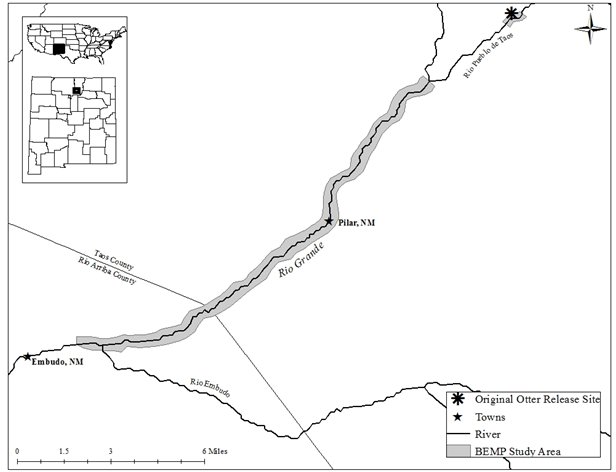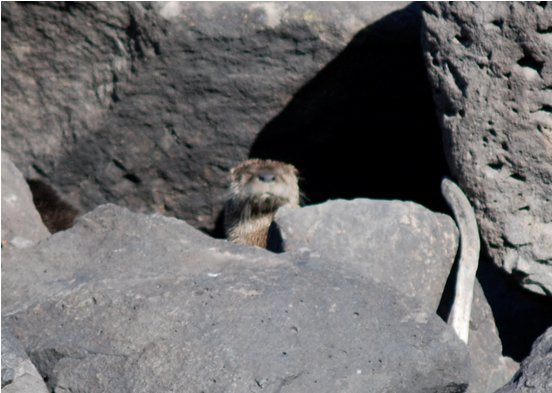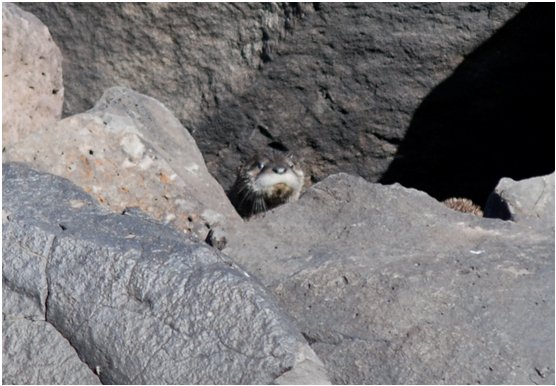IUCN/SSC Otter Specialist Group Bulletin

|
©IUCN/SCC Otter Specialist Group Volume 31 Issue 1 (January 2014) Citation: Converse, R.L., Baron-Deutsch, M., Gjuillin, A. and Rowe, A.J. (2014). Reproduction of Reintroduced North American River Otter (Lontra canadensis) confirmed in New Mexico. IUCN Otter Spec. Group Bull. 31 (1): 35 - 39 Reproduction of Reintroduced North American River Otter (Lontra canadensis) confirmed in New Mexico Rowan L. Converse1, Melina Baron-Deutsch1, Aaron Gjuillin1 and Abram J. Rowe2
1Bosque Ecosystem Monitoring Program (BEMP), University of New Mexico/Bosque School,
Albuquerque, NM, USA. Email: rowan.converse@gmail.com |




|
| Received 31st January 2014, accepted 1st May 2014 |
| Abstract: The North American river otter (Lontra canadensis) was considered to have been extirpated from New Mexico during the second half of the twentieth century. From 2008-2010, the species was reintroduced to the state; since then, there has been no formal study to evaluate the success of the new population. We conducted informal surveys in 2012-2013 in northern New Mexico in an attempt to ascertain basic demographics of the reintroduced population. We observed four otters, an adult and three juveniles, on two occasions during the summer of 2013 on the Rio Grande in Orilla Verde Recreation Area (Taos County). We photographed the adult and one juvenile on one of these occasions. This represents the first confirmed evidence of river otter reproduction since their reintroduction to the state. Additional research will be required to clarify range extents, dietary habits, ecosystem impacts, and other information important to local wildlife managers.. |
| Keywords: observation, reintroduction, Lontra canadensis, juvenile, BEMP |
| Française | Español |
INTRODUCTION
The North American river otter (Lontra canadensis) was historically native to New Mexico’s riverine ecosystems ( Bailey, 1931; Findley et al., 1975 ). It is thought that overhunting and habitat destruction drove the decline of the river otter in New Mexico ( Savage and Klingel, 2008 ). The last known native otter was killed in a beaver trap in 1953 ( McClellan, 1954 ). A few unverified reports of otter in New Mexico between 1953 and 2005 exist mainly from around the area of the Colorado border ( NMGDF, 2006 ). In 2005, Polechla asserted the presence of otter in New Mexico based on genetic analysis of scat samples collected on the San Luis River in the area of Navajo Lake. Due to the general paucity of evidence of otters, the species was considered by managers to be extirpated from the state, or existing in populations too small to be self-sustaining ( Findley et al., 1975 ), though the limited area of the reports indicated possible migration of otters from Colorado ( NMGDF, 2006 ).
In October 2008, five river otters were released by a partnership of federal, state, nonprofit, and tribal agencies into the Rio Pueblo de Taos, a tributary to the Rio Grande. In total, thirty-three otters were released at this site from 2008-2010. There has been no formal demographic study conducted since the release period to assess the reintroduced population. However, some reports compiled by the New Mexico Department of Game and Fish ( NMDGF ) between 2009 and 2012 were suggestive of successful river otter reproduction in New Mexico:
- A female otter collected as roadkill near the Rio Grande south of Pilar (Taos County) in July 2009 appeared to be post-lactating based on the condition of the teats.
- In December 2009, four otters were observed and photographed on the San Juan River in northwestern New Mexico (where the species may be establishing via dispersal from Colorado or Utah) and one was reportedly larger in body size than the others.
- In June 2012, five otters, including one that appeared to be larger than the others, were observed in the Taos Gorge of the Rio Grande
- Two observations of up to six otters together in the lower Rio Chama (another tributary to the Rio Grande) in August 2012 represent another possible family group.
[All reports J. Stuart, NMDGF, pers. comm., 2013]
Taken together, these reports seem to positively indicate otter reproduction in New Mexico. However, until this point in time no photographs clearly confirmed whether or not some of these observed otters may have been juveniles.
In June 2012, the Bosque Ecosystem Monitoring Program (BEMP) began a series of informal summer surveys in order to ascertain basic demographics of the river otter population in northern New Mexico. We surveyed on foot on the bank or on the river in a two-person inflatable kayak. The study area included the Rio Grande from Taos Junction Bridge in the Orilla Verde Recreation Area (Taos County) to the town of Embudo (Rio Arriba County); portions of the Rio Embudo near its confluence with the Rio Grande; and, with permission of the War Chief of Taos Pueblo, the Rio Pueblo de Taos near the original river otter release site ( Fig. 1 ). In the course of this study, an adult otter and three juveniles were observed in two instances during floating surveys within Orilla Verde Recreation Area. We have assumed that the same family group was observed on both instances.
 |
| Figure 1. Overview of BEMP otter study area in northern New Mexico. (click for larger version) |
The otters were first observed during a floating survey on June 15, 2013 in the middle of the Orilla Verde Recreation Area, just above the United States Geologic Survey streamflow gauge in the park (N 36° 19.239’, W 105° 45.244’, +/- 5m). The adult and pups were standing on the rocks of the riverbank, which adjoined the sheer cliff face of the canyon. As we passed by the bank with our kayak, the adult grunted at the pups, who were about half its size and darker in coloration, and the pups hid behind the rocks. The adult remained for some time watching us warily as we observed it, flattening itself against the rocks. We returned to the site two hours later, after the conclusion of the floating survey, in order to photograph the site of the observation for future reference. The otters were still hiding in the rocks, and we managed to photograph the adult and one of the pups from the opposite bank when they poked their heads out of the rocks (Fig. 2 , 3 ). We continued to monitor this site in June and July with floating surveys, observations on foot from the opposite bank, and camera traps, but no further activity was observed at the site. However, we did find and collect fresh scat from a latrine near the site one week after the initial sighting. Due to the limited activity observed at the site after the first instance, as well as the assumed age of the pups based on the time of year, it seems likely that this was a temporary shelter rather than a natal den site.
We observed an adult and two young on one more occasion on June 22, 2013, just below Taos Junction Bridge (N 36 20.082’, W 105 44.135’, +/- ?m). Though there was one fewer juvenile present than in the group observed the week before, we presume that it was the same family group due to the relatively short distance from the site of the first observation. The otters were again standing on rocks adjoining a sheer bank below a small set of rapids. We had not yet set up our camera due to the rapids. The adult startled upon sighting us, and grunted at the pups. The otters dove into the water and fled the area before we could manage to photograph them. The area was monitored carefully on future surveys, but since the site was located directly across the river from a popular campground, we considered it unlikely that this was a regular shelter site for otters given their flight response in the presence of humans
These observations and photographs provide the first confirmation of river otters breeding in New Mexico since their reintroduction to the state. Although a reproducing population of river otter presumably occurred historically in the Rio Grande and other New Mexico rivers, no verified evidence of such a population was known to exist during the second half of the 20th century (J. Stuart, NMDGF, pers. comm. 2013). Reproduction may imply some success to the river otter reintroduction program in northern New Mexico. However, the extent of recolonization by river otters in northern New Mexico is far from clear. Over the course of two summers of study of this population, these were the only two incidents in which we observed live animals. Further research will be required to establish the extent of their range in the state, population estimates, dietary habits, impacts of reintroduction on the local ecosystem, and other important data for local wildlife managers.
Acknowledgements - Thanks to Jim Stuart (NMDGF), Rebecca Belletto, Dan Shaw, and Katie Elder (BEMP) for their extensive and invaluable commentary in reviewing this manuscript. Valerie Williams, Bureau of Land Management; Jim Stuart, New Mexico Department of Game and Fish; the Honorable Samuel Gomez, War Chief of Taos Pueblo 2013; the Honorable Benito Sandoval, War Chief of Taos Pueblo 2012; the War Chief Staff of Taos Pueblo; Jon Klingel; Brian Long; Melissa Savage; Rachel Conn; Dan Shaw; Kimi Scheerer; Kim Fike; Patrick Ryan; Richard Converse; Sydney Van Nortwick; Katie Elder; Hadley Couraud; and Nina Montoya: Thank you for your support of the otter project in its entirety - it would not have been possible without you.
REFERENCES
Bailey, V. (1931). Mammals of New Mexico. North American Fauna 53: 1-412.
Findley, J.S., Harris, A.H. ,Wilson, D.E., Jones, C. (1975). Mammals of New Mexico. University of New Mexico Press, Albuquerque, New Mexico p. 360.
McClellan, J. (1954). An otter catch on the Gila River in southwestern New Mexico. J. Mammal. 35: 443-444.
New Mexico Department of Game and Fish (2006). Feasibility Study: Potential for Restoration of River Otters in New Mexico. NMDGF Report.
Polechla, P.J., Burns, A.G., Rist, S., Moore, K.A. and Dragoo, J.W. (2004)
First Physical Evidence Of The Nearctic River Otter (Lontra canadensis) collected in New Mexico, USA, since 1953.
IUCN Otter Spec. Group Bull.21 (2): 70 -75.
Savage, M., Klingel, J. (2008). The Case for river otter restoration in New Mexico. Four Corners Institute: Report to the New Mexico River Otter Working Group.
Résumé : Confirmation de la Reproduction des Loutres du Canada (Lontra canadensis) Réintroduites dans l’État du Nouveau Mexique
La loutre du Canada (Lontra canadensis) était supposée éteinte de l’état du Nouveau Mexique depuis la deuxième partie du vingtième siècle. Entre 2008 et 2010, l’espèce a été réintroduite dans cet état; depuis aucune étude n’a été conduite pour quantifier l'établissement de cette nouvelle population. Nous avons mené plusieurs études informelles en 2012-2013 dans le nord du Nouveau Mexique dans le but d’établir les bases de la démographie de cette population réintroduite. Nous avons observé quatre loutres, un adulte et trois jeunes, en deux occasions pendant l’été 2013 sur le Rio Grande dans la zone de récréation d’Orilla Verde (Taos Country). Nous avons photographié l’adulte et un juvénile lors d'une de ces occasions. Cela représente la première preuve de reproduction de cette population réintroduite. Des recherches supplémentaires seront nécessaires pour établir l’aire de répartition, le régime alimentaire, les impacts sur l’écosystème, et d’autres informations importantes pour les décideurs environnementaux.
Revenez au dessus
Resumen: Confirmación de la Reproducción en Nuevo Mexico de la Nutria de Río Norteamericana (Lontra canadensis) Reintroducida
Se consideraba que la nutria de río Norteamericana ( Lontra canadensis) había sido extirpada de Nuevo Mexico durante la segunda mitad del siglo veinte. En 2008-2010 la especie fue re-introducida en este estado; desde entonces, no se realizó ningún estudio formal para evaluar el éxito de la nueva población. Realizamos prospecciones informales en el norte de Nuevo Mexico durante 2012-2013, en un intento por comprobar la demografía básica de la población re-introducida. Observamos cuatro nutrias, un adulto y tres juveniles, en dos ocasiones durante el verano de 2013 en el Río Grande, en el Area Recreativa Orilla Verde (Condado de Taos). Fotografiamos al adulto y a un juvenil en una de estas ocasiones. Esto representa la primera evidencia confirmada de reproducción de las nutrias desde su re-introducción en el estado. Será necesaria investigación adicional para clarificar la extensión del área de acción, hábitos alimentarios, impactos en el ecosistema, y otra información importante para los administradores locales de fauna.
Vuelva a la tapa

